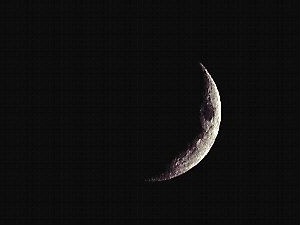Crescent Moon

Uploaded: September 27, 2001
Kodachrome 64; eff. length 600mm; eff. aperture f/11; 1/15th (??); enlarged 2X
Steve McCroskey July 24, 2004
Hi John! Beautiful composition!! I have always wanted to "shoot the moon", but all of mine come out blurry! How did you do this?? #151035John A. Lind July 24, 2004
Focusing and eliminating camera shake are crucial. Focusing is done with extreme care. The lens is mounted to an extremely sturdy professional-grade tripod, and a cable release is used with great care to avoid shaking the camera while operating it. Although not used for this one, I now use a magnifier that slides onto the viewfinder (using the same viewfinder flange an eye cup would use) and an SLR body with a mirror lock-up that makes critical focusing easier and eliminates vibration from "mirror slap."With astro shots, watch your shutter speed! The moon obviously moves across the sky relative to your fixed location on the earth's surface. High magnification with very long focal lengths or through a telescope also magnifies its motion across the film frame. Too long a shutter speed will blur the moon's details from this motion. The alternative is an exceptionally accurate tracking using an "equatorial" mount with analog drive exactly matching the moon's angular motion across the sky that has been very carefully aligned to the combination of earth rotation on its axis and the moon's orbit. How long a shutter speed you can get away with from a fixed tripod depends completely on lens focal length (how much you are magnifying the moon and its motion).
What looks like blur can also result from dew forming on the lens objective. Doesn't take much to fog the whole show! I use a deep lens hood and if I'm out for a while very late at night I will check the lens front for dew formation. Astronomers either work from a dome with aperture (one of the reasons for the dome) or will use a "dew shield" .. . a form of hood that warms the air in the hood very, very slightly to keep it two to three degrees above ambient (too much heat creates convection currents in the air that cause blur).
If you haven't guessed it already, setup for astro photographs requires time and patience ... skill at reliably getting good photos comes with some experience doing it. #667446
Kelly Abernathy
 August 05, 2004
August 05, 2004
Ivan Clife May 14, 2005
omg !!! spectacular shot John !!! really great! please take a look at my gallery if you can, and give me any tips that can help me to improve my photos and shooting. thank'sRegards
Ivan Clife #1350049
Sign up for an interactive online photography course to get critiques on your photos.
Discussions by Category: You can view photo discussions on various themes in the Community > Photo Discussions section of the site.
BetterPhoto Websites: If you see an orange website link directly under the photographer's name, it's totally okay. It's not spam. The reason: BetterPhoto is the one that offers these personal photography websites. We are supporting our clients with those links.
Unavailable EXIF: If there is no other information but 'Unavailable' in the EXIF (meaning no EXIF data exists with the photo), the 'Unavailable' blurb is not displayed. If there is any info, it shows. Many photos have the EXIF stripped out when people modify the image and resave it, before uploading.
The following truth is one of the core philosophies of BetterPhoto:
I hear, I forget.
I see, I remember.
I do, I understand.
You learn by doing. Take your next online photography class.
Copyright for this photo belongs solely to John A. Lind.
Images may not be copied, downloaded, or used in any way without the expressed, written permission of the photographer.
Log in to follow or message this photographer or report this photo.

I already have an account!
